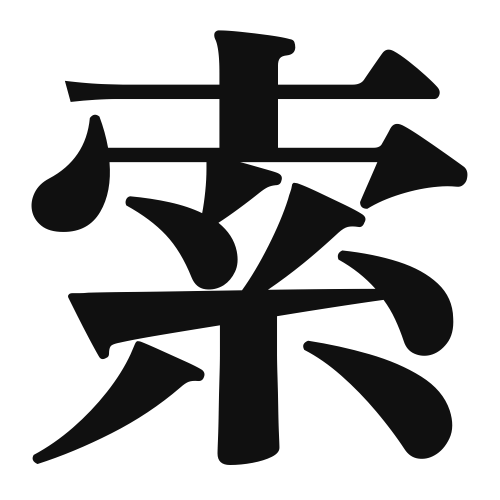1. Overview of Meaning
The kanji 索 (さく, saku) means “search,” “inquiry,” or “cord/rope.” It is often used in contexts related to searching for information or connecting things like with a thread or rope.
2. Origin and Radical
・Origin of the Kanji
索 is a compound ideograph (会意文字), formed by combining visual elements that express related meanings:
- 糸 (いと, ito – thread) – Suggests connection, continuity, or weaving.
- 木 (tree) + 冃 (cover or crown) – Combined to imply “pulling something from a tree with a rope” or the act of searching.
Together, the character represents the idea of drawing or pulling something out — symbolizing the act of searching or extracting.
・Radical
The radical is 糸 (thread), which relates to things involving strings, connections, or weaving.
3. Usage Examples
・Common Words & Phrases
- 検索 (けんさく, kensaku) – Search (e.g., on the internet)
- 探索 (たんさく, tansaku) – Exploration, search
- 索引 (さくいん, sakuin) – Index (like in a book)
・Example Sentence
インターネットで情報を検索しました。
(*Intānetto de jōhō o kensaku shimashita.*)
→ I searched for information on the internet.
4. Synonyms & Antonyms
・Similar Kanji
- 探 (たん, tan / さがす, sagasu) – Also means “to search,” but usually refers to looking for physical things or places.
- 調 (ちょう, chō / しらべる, shiraberu) – Means “to investigate” or “examine,” often in a more analytical context.
・Opposite Kanji
- 放 (ほう, hō / はなす, hanasu) – Means “to release” or “let go,” which is conceptually opposite of seeking or holding on.
- 忘 (ぼう, bō / わすれる, wasureru) – Means “to forget,” which contrasts with the idea of searching or remembering.
5. Cultural & Historical Background
・Connection to Japanese Culture
索 is often seen in compound words related to research, study, and digital search functions. In modern Japan, words like 検索 are ubiquitous in everyday life due to widespread use of the internet.
・Proverbs & Idioms
- 五里霧中を索す (ごりむちゅうをさくす)
(*Gorimuchū o sakusu*)
– “To search in a dense fog.”
This idiom means to search blindly or to be completely lost and unsure of what to do.
